-
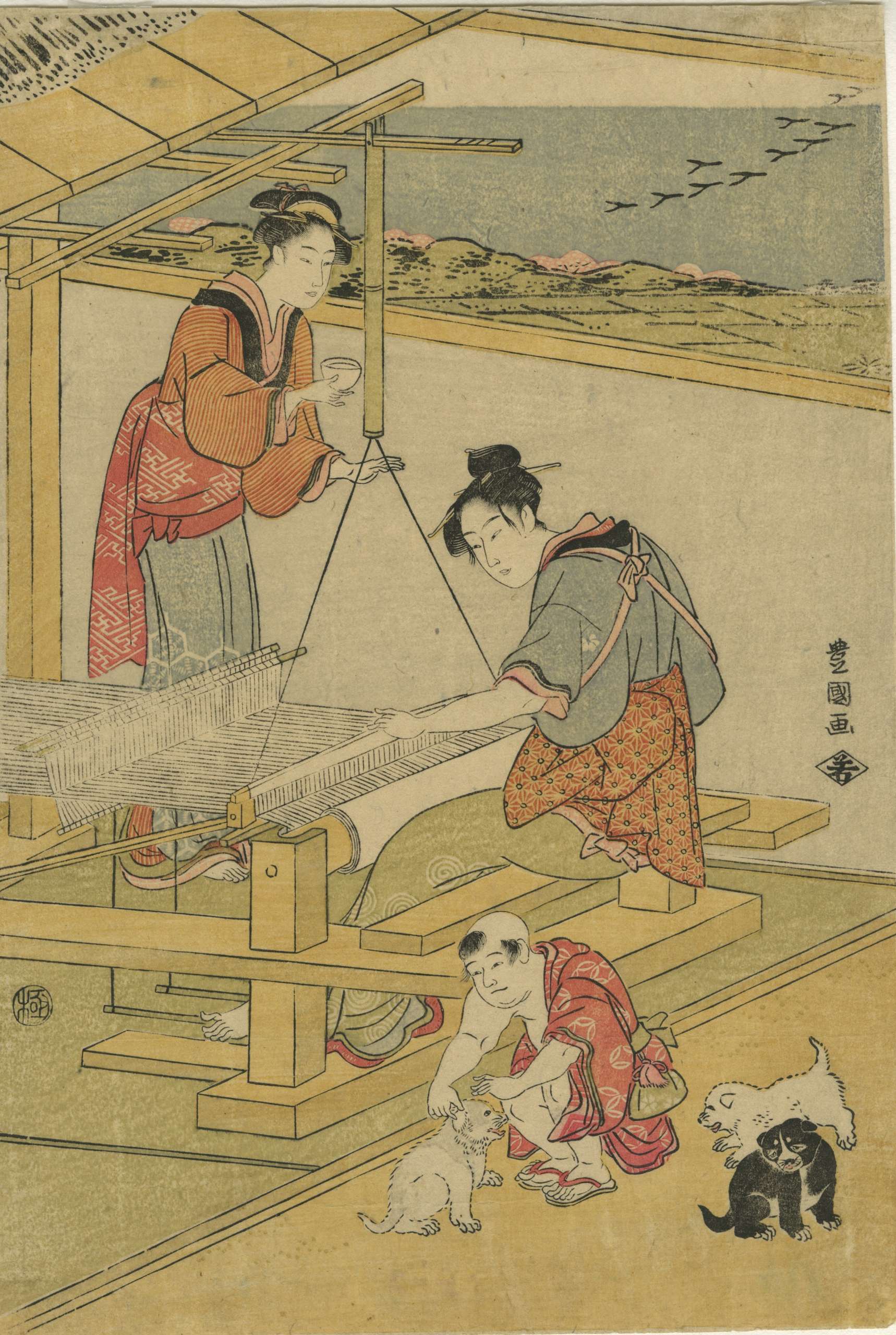 Utagawa Toyokuni I. Women Weaving and Boy Playing with Puppies. c. 1790's. Publisher Wakasaya Yoichi (Jakurindô). Vertical aiban; 32.2 x 21.5 cm (12 11/16 x 8 7/16 in.). MFA ACCESSION NUMBER 06.671. Signed Toyokuni ga 豊国画. Censor's seal: kiwame 改印:極 SOLD
Utagawa Toyokuni I. Women Weaving and Boy Playing with Puppies. c. 1790's. Publisher Wakasaya Yoichi (Jakurindô). Vertical aiban; 32.2 x 21.5 cm (12 11/16 x 8 7/16 in.). MFA ACCESSION NUMBER 06.671. Signed Toyokuni ga 豊国画. Censor's seal: kiwame 改印:極 SOLD -
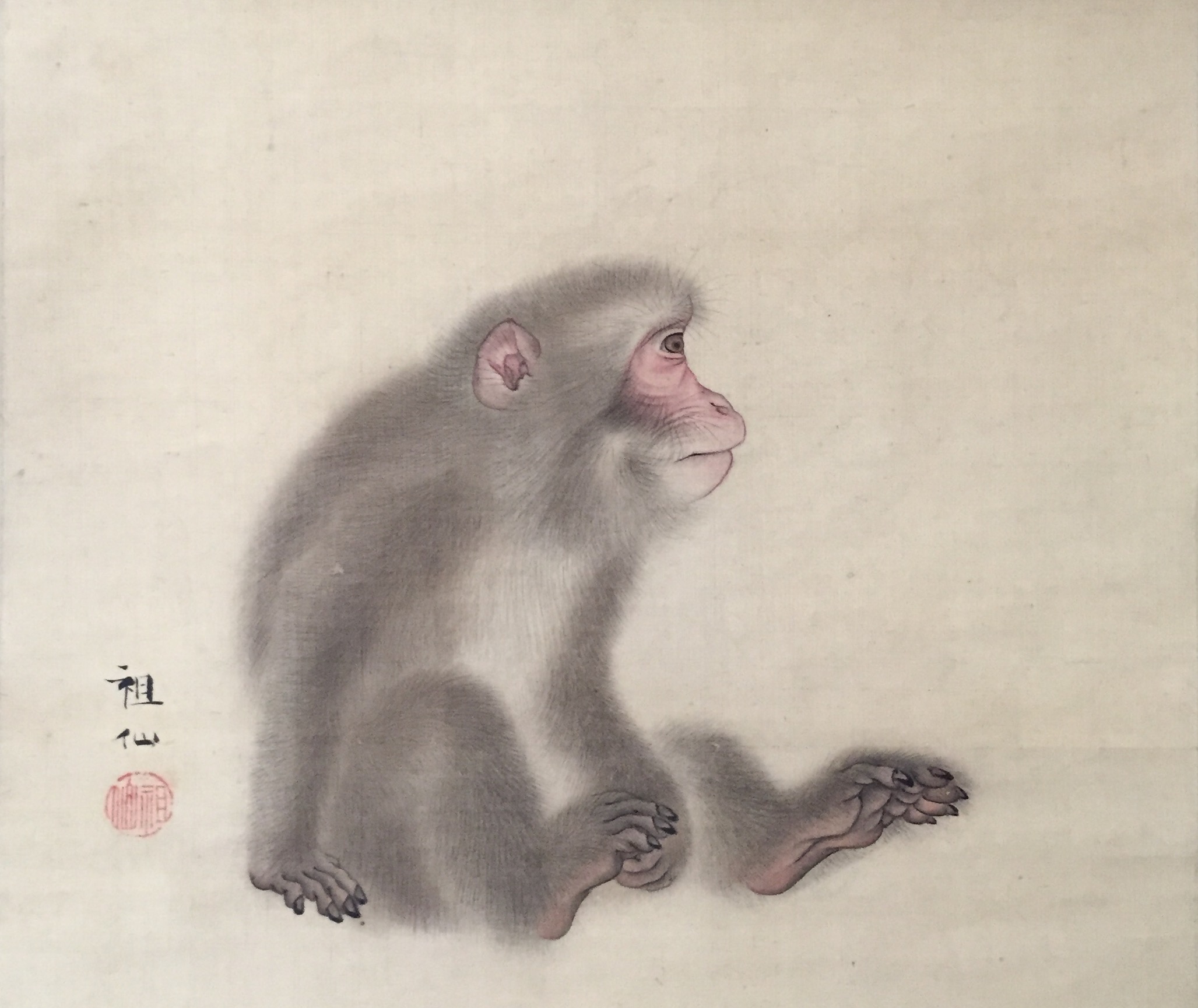 Mori Sosen (1747-1821). Seated Monkey. Hanging scroll painting. Ink and colour on silk. Signed: Sosen. Sealed: Sosen. 28.8 x 33.3 cm.
Mori Sosen (1747-1821). Seated Monkey. Hanging scroll painting. Ink and colour on silk. Signed: Sosen. Sealed: Sosen. 28.8 x 33.3 cm. -
 Kozuka with seven insects (fly, grasshopper, bee, butterfly, dragonfly, firefly, and cricket) and grass with dewdrops motif. Shakudō, flush gold inlay (hira-zōgan). 95.2 (H) x 13.7 mm (W). Mid Edo period (Late 17th - early 18th century, Genroku era 1688-1703). Unsigned. Kaga school. A look-a-like kozuka (with five insects) is illustrated at Japanese Sword Fittings. A descriptive catalogue of the Collection of G.H. Naunton, Esq., completed and illustrated by Henri L. Joly, - 1912 on plate XXIX, №691 [LIB-1389 in this Collection] with the following description at page 54: "Shakudō, inlaid with butterfly, dragon-fly, grasshopper, locust and another insect, gold."
Kozuka with seven insects (fly, grasshopper, bee, butterfly, dragonfly, firefly, and cricket) and grass with dewdrops motif. Shakudō, flush gold inlay (hira-zōgan). 95.2 (H) x 13.7 mm (W). Mid Edo period (Late 17th - early 18th century, Genroku era 1688-1703). Unsigned. Kaga school. A look-a-like kozuka (with five insects) is illustrated at Japanese Sword Fittings. A descriptive catalogue of the Collection of G.H. Naunton, Esq., completed and illustrated by Henri L. Joly, - 1912 on plate XXIX, №691 [LIB-1389 in this Collection] with the following description at page 54: "Shakudō, inlaid with butterfly, dragon-fly, grasshopper, locust and another insect, gold." See also tsuba TSU-0211 in this collection:
See also tsuba TSU-0211 in this collection:


-
 This tsuba is a cut from a typical Bizen Shōami butterfly tsuba (see TSU-0100 in this collection), which normally would have had a circular rim around the butterfly. In this particular example of altered guard we have both eyes of the insect (inlaid in brass or copper) intact. The kebori carving is more pronounced than in TSU-0100 example. Copper sekigane. Unsigned. Attributed to Bizen Shōami school, early Edo period (17th century). Dimensions: 64.7 x 63.7 x 5.2 mm References: see TSU-0100.
This tsuba is a cut from a typical Bizen Shōami butterfly tsuba (see TSU-0100 in this collection), which normally would have had a circular rim around the butterfly. In this particular example of altered guard we have both eyes of the insect (inlaid in brass or copper) intact. The kebori carving is more pronounced than in TSU-0100 example. Copper sekigane. Unsigned. Attributed to Bizen Shōami school, early Edo period (17th century). Dimensions: 64.7 x 63.7 x 5.2 mm References: see TSU-0100. -

Iron tsuba of oval form decorated with design of jakago (bamboo lattice work) in openwork (sukashi). Copper sekigane.
Unsigned. Edo period.
Size: 73.7 x 70.3 x 5.6 mm.Note regarding design: though some might think that this piece belonged to a member of the lost tribe of Israel, it did not. Jakago baskets were made of bamboo, filled with rocks and used to catch crabs (besides other uses).

Jeanne Allen. Designer's Guide to Samurai Patterns. Chronicle Books, San Francisco, 1990; p.51, №57.
-
 Utagawa Kunisada (Japanese: 歌川 国貞; also known as Utagawa Toyokuni III (三代歌川豊国); 1786 – 12 January 1865).
Utagawa Kunisada (Japanese: 歌川 国貞; also known as Utagawa Toyokuni III (三代歌川豊国); 1786 – 12 January 1865).A young woman reading a book in the light of a lamp. Series: Arigataki miyo no kage-e (Shadow Pictures of an Auspicious Age). There are five known prints, half-length portraits of beauties, in this series, designed by Kunisada in ca. 1844. Another print from the series in this collection: SVJP-0306.2020: A young woman adjusting her hairpins in the light of a paper lantern.
Signed: Kōchōrō Toyokuni ga (香蝶楼豊国画).
Publisher: Maruya Kiyojiro.
Size: Vertical Ōban (37.5 x 25.4 cm). -
 Artist: Utagawa Kunisada [歌川 国貞], a.k.a. Utagawa Toyokuni III [三代 歌川 豊国] (Japanese, 1786 – 1865). Signed: Toyokuni ga [豊国 画] in a red toshidama cartouche Block carver: Yokokawa Takejirō [横川竹二郎] (Japanese, fl. 1845 – 1863); seal: Hori Take [彫竹]. Publisher: Iseya Magobei [伊勢屋孫兵衛] (Japanese, fl. c. 1794 – 1868); seal: Hanmoto, Masu [板元, 益] (Marks 19-039 | 150d). Date-aratame seal: Ansei 2 (1855). Title: Time in Fukagawa, Iyo Province (Fukagawa Iyo setsu). Ref.: [LIB-3008.2022] Andreas Marks. Japanese woodblock prints: Artists, publishers and masterworks, 1680 – 1900. — Tuttle Publishing, 2010; p. 221. –> 1855 Kunisada. "Iyo Province-time at Fukagawa" (Fukagawa Iyo setsu). Fan print. Japan Ukiyo-e Museum, Matsumoto.
Artist: Utagawa Kunisada [歌川 国貞], a.k.a. Utagawa Toyokuni III [三代 歌川 豊国] (Japanese, 1786 – 1865). Signed: Toyokuni ga [豊国 画] in a red toshidama cartouche Block carver: Yokokawa Takejirō [横川竹二郎] (Japanese, fl. 1845 – 1863); seal: Hori Take [彫竹]. Publisher: Iseya Magobei [伊勢屋孫兵衛] (Japanese, fl. c. 1794 – 1868); seal: Hanmoto, Masu [板元, 益] (Marks 19-039 | 150d). Date-aratame seal: Ansei 2 (1855). Title: Time in Fukagawa, Iyo Province (Fukagawa Iyo setsu). Ref.: [LIB-3008.2022] Andreas Marks. Japanese woodblock prints: Artists, publishers and masterworks, 1680 – 1900. — Tuttle Publishing, 2010; p. 221. –> 1855 Kunisada. "Iyo Province-time at Fukagawa" (Fukagawa Iyo setsu). Fan print. Japan Ukiyo-e Museum, Matsumoto. -
 Artist: Katsukawa Shunkō [勝川 春好] (Japanese, 1743 – 1812).
Artist: Katsukawa Shunkō [勝川 春好] (Japanese, 1743 – 1812).Actor: Matsumoto Kōshirō IV [[松本幸四郎]; other names: Omegawa Kyōjūrō, Ichikawa Komazō II, Ichikawa Somegorô I, Ichikawa Takejūrō, Segawa Kinji, Segawa Kingo] (Japanese, 1737 – 1802).
Signed: Shunkō ga. Size: Hosoban; 14 x 33 cm. SOLD -
 Artist: Utagawa Kunisada [歌川 国貞] a.k.a. Utagawa Toyokuni III [三代歌川豊国] (Japanese, 1786 – 1865). No publisher seal, no date or censor seal; probably a private printing. Signed: Kunisada ga [国貞画] in a red double gourd cartouche. Media: Untrimmed fan print (uchiwa-e), 231 x 294 mm, with the use of mica and black lacquer.
Artist: Utagawa Kunisada [歌川 国貞] a.k.a. Utagawa Toyokuni III [三代歌川豊国] (Japanese, 1786 – 1865). No publisher seal, no date or censor seal; probably a private printing. Signed: Kunisada ga [国貞画] in a red double gourd cartouche. Media: Untrimmed fan print (uchiwa-e), 231 x 294 mm, with the use of mica and black lacquer. -

Fuchi-kashira made of shakudō carved and inlaid with gold and red copper with the design of a bat and a fruit (persimmon?). Nanako surface.
Fuchi: 37 x 19 x 7 mm. Kashira: 34 x 16 x 5 mm. Main material: shakudō. Other metals: gold and copper. Surface treatment: nanako-ji. -
 Iron tsuba with design of bamboo and sparrow (take-ni-suzume) in openwork (sukashi). Rounded rim. Copper sekigane. Akasaka school. Unsigned. Attributed to second generation Tadamasa Shōzaemon (died in in the fifth year of Enppo, 1677). Early Edo period: 17th century (Kan-ei / Kanbun era). Height: 79.0 mm. Width: 77.5 mm. Rim thickness: 5.5 mm. Center thickness: 6.6 mm. Provenance: Sasano Masayuki Collection, № 222: "It is believed that sparrows nest in a bamboo grove". According to Merrily Baird [Merrily Baird. Symbols of Japan. Thematic motifs in art and design. Rizzoli international publications, Inc., 2001], "a bamboo grove is said to be emblematic of security as the bamboo is resilient even in the face of high winds and heavy rains. [...] The association of the sparrow (suzume) with bamboo is an old one found in Japanese poetry, paining, and design. The bird is said to be obsessed with its honor, especially the repaying of debts".
Iron tsuba with design of bamboo and sparrow (take-ni-suzume) in openwork (sukashi). Rounded rim. Copper sekigane. Akasaka school. Unsigned. Attributed to second generation Tadamasa Shōzaemon (died in in the fifth year of Enppo, 1677). Early Edo period: 17th century (Kan-ei / Kanbun era). Height: 79.0 mm. Width: 77.5 mm. Rim thickness: 5.5 mm. Center thickness: 6.6 mm. Provenance: Sasano Masayuki Collection, № 222: "It is believed that sparrows nest in a bamboo grove". According to Merrily Baird [Merrily Baird. Symbols of Japan. Thematic motifs in art and design. Rizzoli international publications, Inc., 2001], "a bamboo grove is said to be emblematic of security as the bamboo is resilient even in the face of high winds and heavy rains. [...] The association of the sparrow (suzume) with bamboo is an old one found in Japanese poetry, paining, and design. The bird is said to be obsessed with its honor, especially the repaying of debts". -
 Similar image at MFA under title: Actors and Women in the Snow MFA ACCESSION NUMBER: 11.13568 Date: 1809 (Bunka 6), 12th month Artist: Utagawa Toyokuni I (1769–1825) Publisher Tsuruya Kinsuke (firm name Sôkakudô), № 554 in Marks's "Publishers". DIMENSIONS: Vertical ôban; 38.2 x 25.8 cm (15 1/16 x 10 3/16 in.) MEDIUM OR TECHNIQUE: Woodblock print (nishiki-e); ink and color on paper. Signed: Toyokuni ga (豊国画) Censor's seals: kiwame (改印:極) MFA assumes that this may be "one sheet of incomplete triptych?"
Similar image at MFA under title: Actors and Women in the Snow MFA ACCESSION NUMBER: 11.13568 Date: 1809 (Bunka 6), 12th month Artist: Utagawa Toyokuni I (1769–1825) Publisher Tsuruya Kinsuke (firm name Sôkakudô), № 554 in Marks's "Publishers". DIMENSIONS: Vertical ôban; 38.2 x 25.8 cm (15 1/16 x 10 3/16 in.) MEDIUM OR TECHNIQUE: Woodblock print (nishiki-e); ink and color on paper. Signed: Toyokuni ga (豊国画) Censor's seals: kiwame (改印:極) MFA assumes that this may be "one sheet of incomplete triptych?" -
 Suzuki Harunobu (鈴木 春信; c. 1725 – 15 July 1770).
Suzuki Harunobu (鈴木 春信; c. 1725 – 15 July 1770).The Ide Jewel River, a Famous Place in Yamashiro Province (Ide no Tamagawa, Yamashiro no meisho), from the series The Six Jewel Rivers in Popular Customs (Fûzoku Mu Tamagawa).
Signed: Harunobu gaInscription - Poem: Koma tomete/ nao mizu kawan/ yamabuki no/ hana no tsuyu sou/ Ide no Tamagawa
References:MFA # 21.4540.
Waterhouse cat. #562; Pins, The Japanese Pillar Print (1982), #139; Ukiyo-e shûka 4 (1979), list #795.4, and supp. 2 (1982), pl. 565; Gentles, AIC cat. II (1965), p. 125, #201.
-
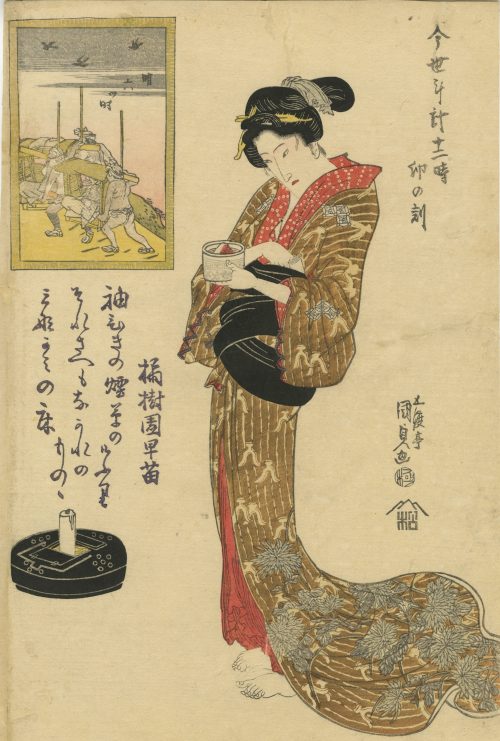 Artist: Utagawa Kunisada [歌川 国貞] a.k.a. Utagawa Toyokuni III [三代歌川豊国] (Japanese, 1786 – 1865). Publisher: Matsumura Tatsuemon [松村辰右衛門] (Japanese, fl. c. 1793 – 1832). Year: c. 1820–22 (Bunsei era). Signed: 五渡亭国貞画 – Gototei Kunisada ga. Censor's seal: kiwame 改印:極
Artist: Utagawa Kunisada [歌川 国貞] a.k.a. Utagawa Toyokuni III [三代歌川豊国] (Japanese, 1786 – 1865). Publisher: Matsumura Tatsuemon [松村辰右衛門] (Japanese, fl. c. 1793 – 1832). Year: c. 1820–22 (Bunsei era). Signed: 五渡亭国貞画 – Gototei Kunisada ga. Censor's seal: kiwame 改印:極

SVJP-0179-6.2014
The Hour of the Dragon, Fifth Hour of Day (Tatsu no koku, Hi no itsutsu toki), from the series Twelve Hours of a Modern Clock (Imayo tokei jūniji) 「今世時計十二時 辰ノ刻 日ノ五つ時」 MFA impression: 11.15315. 
SVJP-0179-1.2014
The Hour of the Rabbit, Sixth Hour of Day (U no koku, Ake muttsu toki), from the series Twelve Hours of a Modern Clock (Imayo tokei jūniji) 「今世時計十二時 卯ノ刻 明六つ時」. MFA impression: 11.15317 
SVJP-0179-2.2014
The Hour of the Monkey, Seventh Hour of Day (Saru no koku, Hi no nanatsu toki), from the series Twelve Hours of a Modern Clock (Imayo tokei jūniji) 「今様時計十二時 申ノ刻 日ノ七つ時」 MFA impression: 11.39692 
SVJP-0179-8.2014
The Hour of the Horse, Ninth Hour of Day (Uma no koku, Hi kokonotsu toki), from the series Twelve Hours of a Modern Clock (Imayo tokei jūniji) 「今世時計十二時 午ノ刻 日九つ時」. MFA impression: 11.15314 
SVJP-0179-4.2014
The Hour of the Boar, Fourth Hour of Night (I no koku, Yoru yottsu toki), from the series Twelve Hours of a Modern Clock (Imayo tokei jūniji) 「今世時計十二時 亥ノ刻 夜四つ時」. MFA impression: 11.15552 
SVJP-0179-3.2014
The Hour of the Tiger, Seventh Hour of Night (Tora no koku, Yoru nanatsu), from the series Twelve Hours of a Modern Clock (Imayo tokei jūniji) 「今世時計十二時 寅ノ刻 夜七つ」. MFA impression: 11.15313 Ref.: Izzard. Kunisada’s world [LIB-2970.2022]. 
SVJP-0179-5.2014
The Hour of the Ox, Eight Hour of Night (Ushi no koku, Yoru no yattsu toki), from the series Twelve Hours of a Modern Clock (Imayo tokei jūniji) 「今世時計十二時 丑ノ刻 夜ノ八つ時」. MFA impression: 11.26906 
SVJP-0179-7.2014
The Hour of the Rat, Ninth Hour of Night (Ne no koku, Yoru kokonotsu toki), from the series Twelve Hours of a Modern Clock (Imayo tokei jūniji) 「今世時計十二時 子ノ刻 夜九つ時」. MFA impression: 11.15312 -
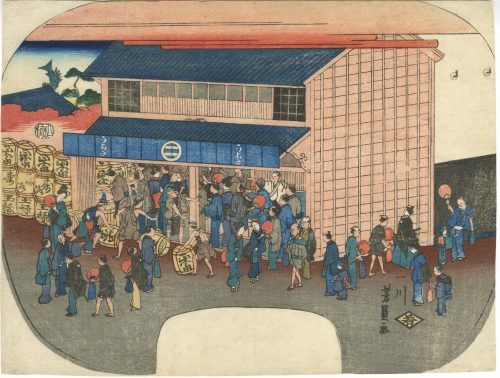 Artist: Utagawa Yoshikazu [歌川芳員] (Japanese, fl. c. 1850 – 1870). Publisher: Wakasaya Yoichi [若狭屋与市] (Japanese, fl. 1794 – 1897). Combined date seal and kiwame censor seal: 1861 (Man'en 2 / Bunkyū 1, from 19/02).
Artist: Utagawa Yoshikazu [歌川芳員] (Japanese, fl. c. 1850 – 1870). Publisher: Wakasaya Yoichi [若狭屋与市] (Japanese, fl. 1794 – 1897). Combined date seal and kiwame censor seal: 1861 (Man'en 2 / Bunkyū 1, from 19/02). -
 Artist: Utagawa Kunisada [歌川 国貞] a.k.a. Utagawa Toyokuni III [三代歌川豊国] (Japanese, 1786 – 1865). Signed: Toyokuni ga [豊国 画] in a red toshidama cartouche. Publisher: Ibaya Senzaburō [伊場屋仙三郎] (Japanese, c. 1815 – 1869). Block carver: Yokokawa Takejirō [横川竹二郎] (Japanese, fl. 1845 – 1863); seal Hori Take [彫竹]. Double nanushi censor seals: Mera & Murata (1847-50). Title: Cool Breeze on Tenpōzan Hill in Naniwa [浪花天保山の涼] (Naniwa Tenpōzan no ryō). An uncut fan print (uchiwa-e), depicting a gentleman (most probably kabuki actor Nakamura Utaemon IV) holding a pipe with the view of Tenpōzan Hill [天保山] in Naniwa (Osaka) in the background. A distinctive structure on the left is the Sumiyoshi Lantern [住吉高灯篭] (Sumiyoshi takadōrō), which was destroyed by a typhoon in 1950. The character 翫 – moteasobu – on the gentleman’s robe means "take pleasure, play an instrument". Nakamura Utaemon IV [中村歌右衛門] (Japanese, 1796 – 1852); other names: Nakamura Shikan II, Nakamura Tsurusuke I, Nakamura Tōtarō. The character is visually similar to a gentleman drinking tea on a veranda under the shining moon from the series ‘Moon, Sun, Stars’ [月日星] (Getsu hi hoshi), see SVJP-0211-1.2016: The Moon.
Artist: Utagawa Kunisada [歌川 国貞] a.k.a. Utagawa Toyokuni III [三代歌川豊国] (Japanese, 1786 – 1865). Signed: Toyokuni ga [豊国 画] in a red toshidama cartouche. Publisher: Ibaya Senzaburō [伊場屋仙三郎] (Japanese, c. 1815 – 1869). Block carver: Yokokawa Takejirō [横川竹二郎] (Japanese, fl. 1845 – 1863); seal Hori Take [彫竹]. Double nanushi censor seals: Mera & Murata (1847-50). Title: Cool Breeze on Tenpōzan Hill in Naniwa [浪花天保山の涼] (Naniwa Tenpōzan no ryō). An uncut fan print (uchiwa-e), depicting a gentleman (most probably kabuki actor Nakamura Utaemon IV) holding a pipe with the view of Tenpōzan Hill [天保山] in Naniwa (Osaka) in the background. A distinctive structure on the left is the Sumiyoshi Lantern [住吉高灯篭] (Sumiyoshi takadōrō), which was destroyed by a typhoon in 1950. The character 翫 – moteasobu – on the gentleman’s robe means "take pleasure, play an instrument". Nakamura Utaemon IV [中村歌右衛門] (Japanese, 1796 – 1852); other names: Nakamura Shikan II, Nakamura Tsurusuke I, Nakamura Tōtarō. The character is visually similar to a gentleman drinking tea on a veranda under the shining moon from the series ‘Moon, Sun, Stars’ [月日星] (Getsu hi hoshi), see SVJP-0211-1.2016: The Moon. As noted by Horst Graebner, the gentleman also resembles the character on another Kunisada's actor print, published in 1852 (Waseda University Cultural Resources Database № 114-0232):
As noted by Horst Graebner, the gentleman also resembles the character on another Kunisada's actor print, published in 1852 (Waseda University Cultural Resources Database № 114-0232):

-
 Artist: Utagawa Kunisada [歌川 国貞], a.k.a. Utagawa Toyokuni III [三代 歌川 豊国] (Japanese, 1786 – 1865). Signed: Toyokuni ga [豊国 画] in a red toshidama cartouche Block carver: Yokokawa Takejirō [横川竹二郎] (Japanese, fl. 1845 – 1863), seal: 彫竹 – hori Take. Publisher: Ibaya Senzaburō [伊場屋仙三郎] (Japanese, fl. c. 1845 – 1847). Media: Untrimmed fan print (uchiwa-e), 238 x 304 mm. Title: Saiko (West River) [西江]; 西江 means the Xi River in China. Series: Chronicles of Elegant Women [風雅女史傳] (Fūga joshiden). Combined date seal and kiwame censor seal: Ansei 6 (1859). Other prints from the same series in this collection: SVJP-0216.2016 — Princess Sotoori:
Artist: Utagawa Kunisada [歌川 国貞], a.k.a. Utagawa Toyokuni III [三代 歌川 豊国] (Japanese, 1786 – 1865). Signed: Toyokuni ga [豊国 画] in a red toshidama cartouche Block carver: Yokokawa Takejirō [横川竹二郎] (Japanese, fl. 1845 – 1863), seal: 彫竹 – hori Take. Publisher: Ibaya Senzaburō [伊場屋仙三郎] (Japanese, fl. c. 1845 – 1847). Media: Untrimmed fan print (uchiwa-e), 238 x 304 mm. Title: Saiko (West River) [西江]; 西江 means the Xi River in China. Series: Chronicles of Elegant Women [風雅女史傳] (Fūga joshiden). Combined date seal and kiwame censor seal: Ansei 6 (1859). Other prints from the same series in this collection: SVJP-0216.2016 — Princess Sotoori:

-
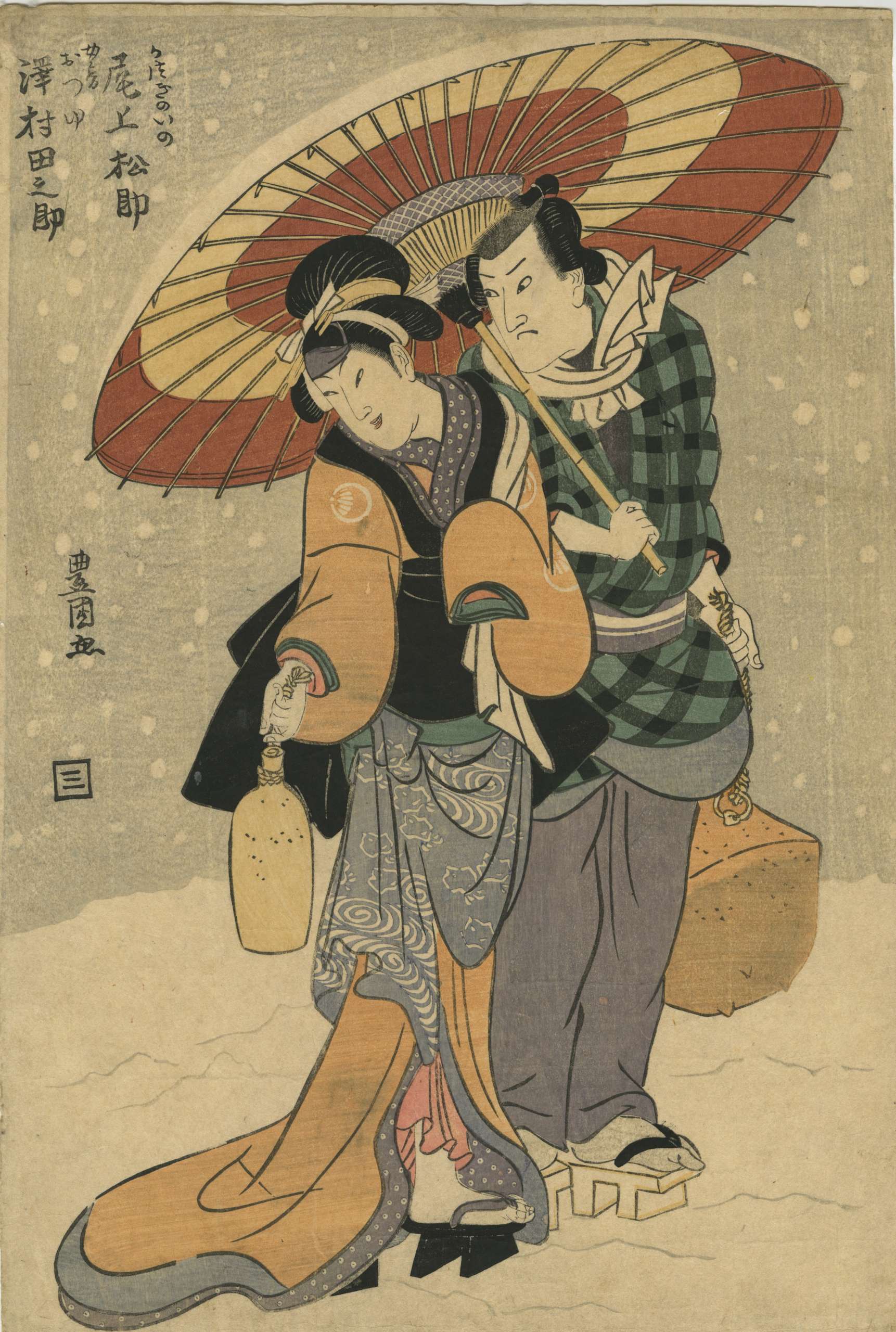 Utagawa Toyokuni (歌川豐國); 1769 – 24 February 1825. Actor Onoe Matsusuke II as Katsugiino (right), actor Sawamura Tanosuke II as Otsuyu (left) 尾上松助(二代目)in a role かつぎいの; 沢村田之助(二代目) in a role おつゆ. Play: "Yuki to Tsuki Hana no Kuronushi". Theater: Nakamura. Publisher: Mikawaua Seiemon (1805-1829) [Marks: 328]. Circa 1810.
Utagawa Toyokuni (歌川豐國); 1769 – 24 February 1825. Actor Onoe Matsusuke II as Katsugiino (right), actor Sawamura Tanosuke II as Otsuyu (left) 尾上松助(二代目)in a role かつぎいの; 沢村田之助(二代目) in a role おつゆ. Play: "Yuki to Tsuki Hana no Kuronushi". Theater: Nakamura. Publisher: Mikawaua Seiemon (1805-1829) [Marks: 328]. Circa 1810.


